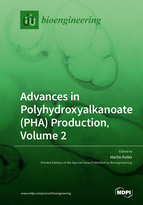Advances in Polyhydroxyalkanoate (PHA) Production, Volume 2
A special issue of Bioengineering (ISSN 2306-5354).
Deadline for manuscript submissions: closed (31 October 2019) | Viewed by 95621
Special Issue Editor
Interests: polyhydroxyalkanoates (PHA); biopolymers; fermentation technology; downstream processing; sustainable process development
Special Issues, Collections and Topics in MDPI journals
Special Issue Information
Dear Colleagues,
Nowadays, we are witnessing highly dynamic research activities related to the intriguing field of biodegradable materials with plastic-like properties. These activities are provoked by a strengthened public awareness of prevailing ecological issues connected to growing piles of plastic waste and increasing greenhouse gas emissions; this goes hand-in-hand with the ongoing depletion of fossil feedstocks, which are traditionally used to produce full carbon backbone polymers. To a steadily increasing extend, polyhydroxyalkanoate (PHA) biopolyesters, a family of plastic-like materials with versatile material properties, are considered a future-oriented solution for diminishing these concerns. PHA production is based on renewable resources, and occurs in a bio-mediated fashion by the action of living organisms. If accomplished in an optimized way, PHA production and the entire PHA lifecycle are embedded into nature´s closed cycles of carbon.
You as a highly recognized expert in this field are aware of the fact that sustainable and efficient PHA production requires the understanding and improvement of all individual process steps. Holistic improvement of PHA production, applicable on an industrially relevant scale, calls for inter alia: consolidated knowledge about the enzymatic and genetic particularities of PHA accumulating organisms, in-depth understanding of the kinetics of the bioprocess, the selection of appropriate inexpensive fermentation feedstocks, tailoring the composition of PHA on the level of the monomeric constituents, optimized biotechnological engineering, and novel strategies for PHA recovery from biomass characterized by minor energy and chemical requirement.
In order to provide a comprehensive compilation of articles addressing all these individual aspects, we are contacting globally recognized experts like you. We are convinced that a contribution based on your special expertise in the PHA arena will be of major benefit to make this Special Issue even more attractive to the scientific community.
Dr. Martin Koller
Guest Editor
Manuscript Submission Information
Manuscripts should be submitted online at www.mdpi.com by registering and logging in to this website. Once you are registered, click here to go to the submission form. Manuscripts can be submitted until the deadline. All submissions that pass pre-check are peer-reviewed. Accepted papers will be published continuously in the journal (as soon as accepted) and will be listed together on the special issue website. Research articles, review articles as well as short communications are invited. For planned papers, a title and short abstract (about 100 words) can be sent to the Editorial Office for announcement on this website.
Submitted manuscripts should not have been published previously, nor be under consideration for publication elsewhere (except conference proceedings papers). All manuscripts are thoroughly refereed through a single-blind peer-review process. A guide for authors and other relevant information for submission of manuscripts is available on the Instructions for Authors page. Bioengineering is an international peer-reviewed open access monthly journal published by MDPI.
Please visit the Instructions for Authors page before submitting a manuscript. The Article Processing Charge (APC) for publication in this open access journal is 2700 CHF (Swiss Francs). Submitted papers should be well formatted and use good English. Authors may use MDPI's English editing service prior to publication or during author revisions.
Keywords
- Polyhydroxyalkanoate (PHA)
- Biopolyesters
- Bioprocess Design
- Sustainable Development







